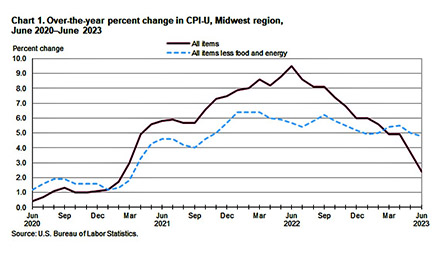KANSAS CITY, Kan. – Prices in the Midwest Region, as measured by the Consumer Price Index for All Urban Consumers (CPI-U), advanced 0.4 percent in June, the U.S. Bureau of Labor Statistics reported.
The June increase was mainly driven by higher costs for owners’ equivalent rent of residences and electricity.
Over the last 12 months, the CPI-U rose 2.4 percent. The index for all items less food and energy increased 4.8 percent over the year. Food prices were up 5.9 percent compared to June 2022 levels.
Energy prices decreased 20.3 percent, largely the result of a decline in the price of gasoline. (See chart 1.)

Food
Food prices were unchanged for the month of June. The index for food at home declined 0.3 percent, while prices for food away from home rose 0.4 percent over the same period. Within the food at home index, prices for fruits and vegetables and nonalcoholic beverages and beverage materials showed the largest decreases, down 0.7 percent, and 0.8 percent, respectively.
Over the year, food prices advanced 5.9 percent. The indexes for food at home and food away from home both advanced over this period, 4.8 percent and 7.9 percent, respectively. All six major components within the index for food at home (grocery store prices) increased, with the largest advances seen in the other food at home (+7.0 percent) and cereals and bakery products (+9.3 percent) categories.
Energy
The energy index rose 2.3 percent in June, mainly due to higher prices for electricity (+6.0 percent), but rising gasoline prices also contributed (+1.0 percent). Prices for natural gas service fell 0.9 percent over the month.
From June 2022 to June 2023, energy prices decreased 20.3 percent, largely due to lower prices for gasoline (-28.1 percent) and natural gas service (-31.2 percent). Prices paid for electricity advanced 6.2 percent over the past year.
All items less food and energy
The index for all items less food and energy rose 0.3 percent in June, almost entirely driven by higher prices for shelter (+0.7 percent) and used cars and trucks (+1.1 percent). Lower prices for public transportation, education and communication (-0.5 percent) and apparel (-1.0 percent) slightly offset these increases.
Over the year, the index for all items less food and energy increased 4.8 percent. Rising prices in the three shelter components – owners’ equivalent rent of residences (+6.9 percent), rent of primary residence (+7.3 percent), and lodging away from home – drove the advance. Other notable increases occurred within the recreation and household furnishings and operations categories, which rose 6.1 percent and 4.3 percent, respectively. Partly offsetting these advances was a price decline in used cars and trucks, which fell 4.5 percent over the year.
